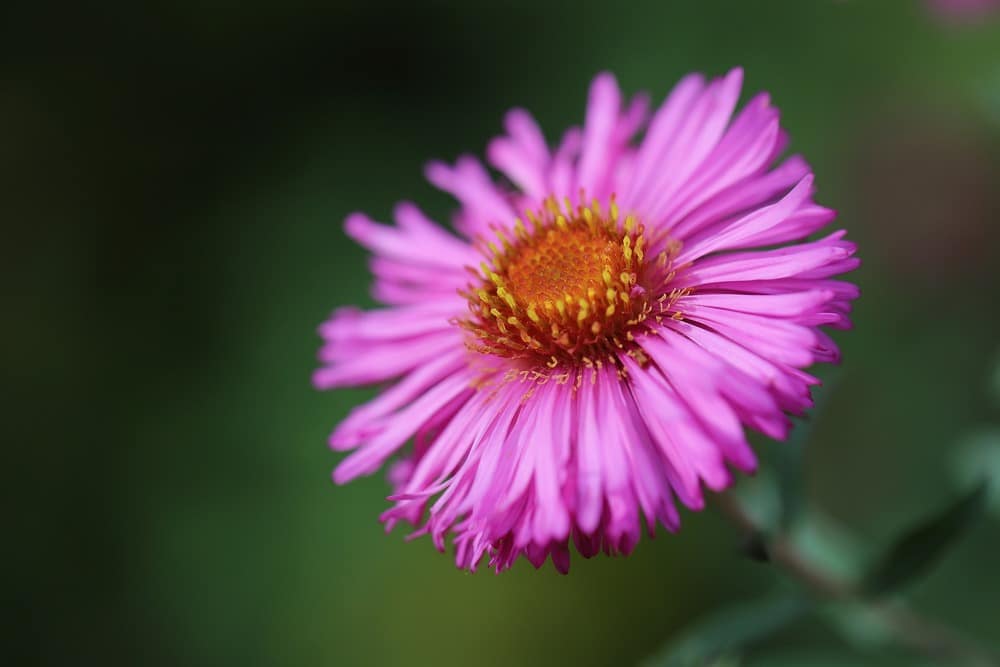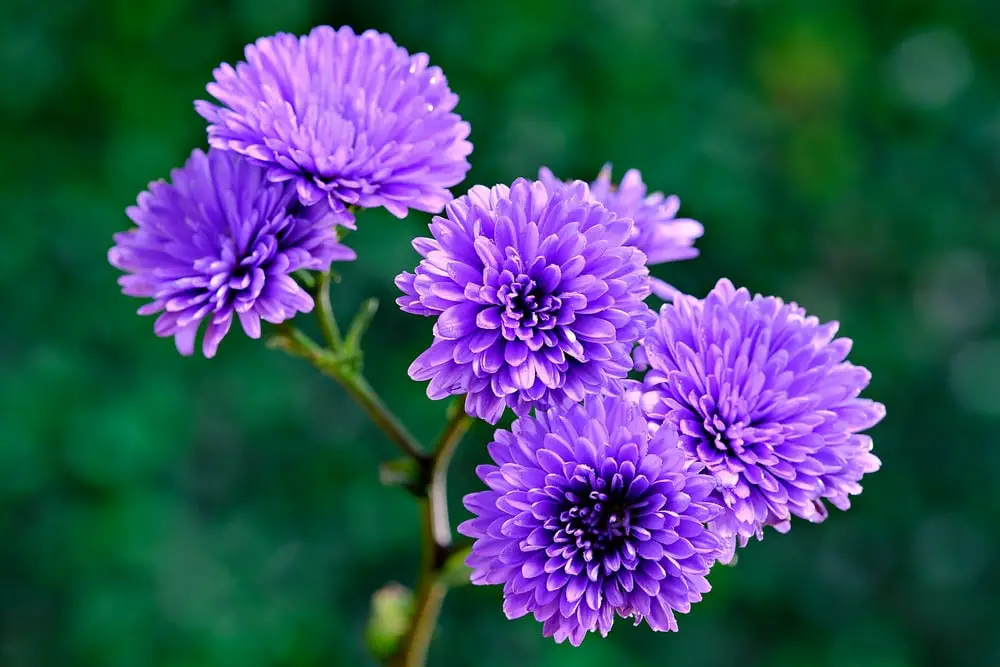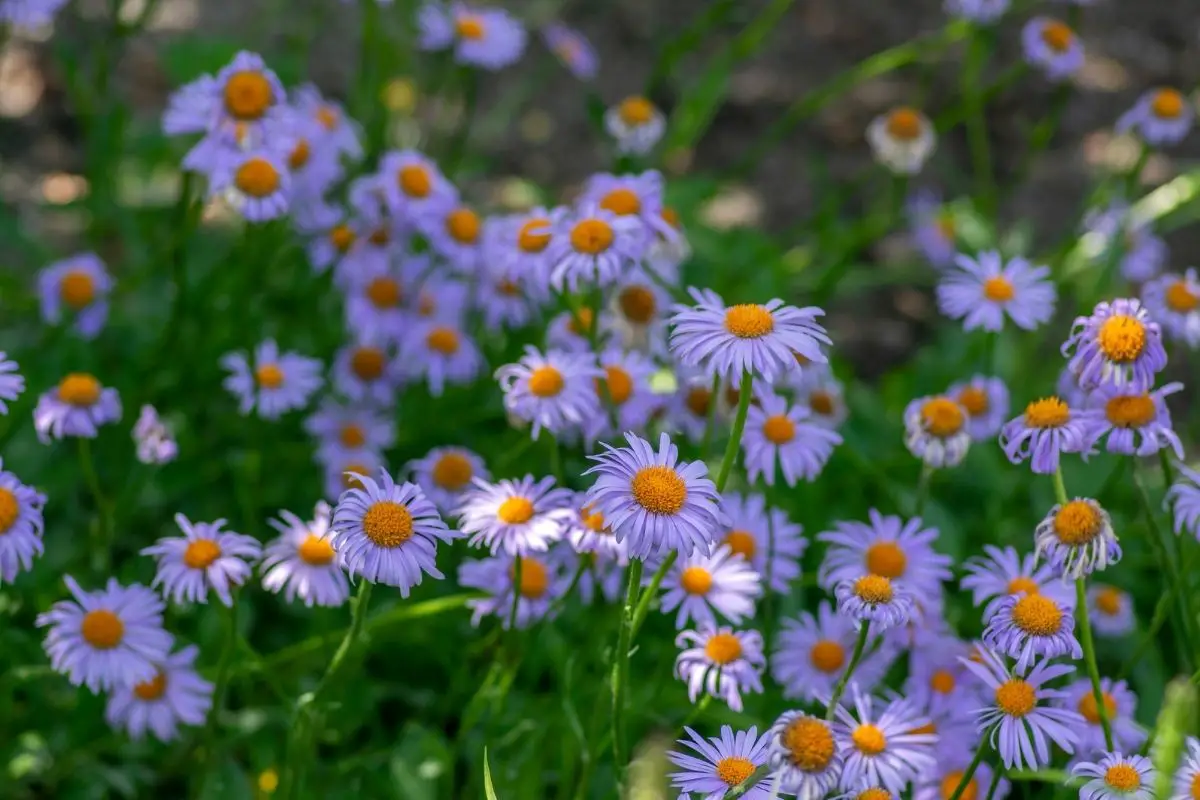You might confuse an aster for a daisy, but the two are quite different if you take a closer look! Both flowers belong to the same family but each has its own unique flower meaning and symbolism.
An aster is as bright as any flower in the garden with its lush petals, just like how a star lights up the night sky. A twinkle, twinkle little star. These beautiful blooms create a gorgeous texture of ground cover plants when in full bloom. It comes in a variety of colors that are all eye pleasing.
These popular flowers are commonly used as an ornamental or edible flower. Its various colors include white which means purity and yellow which symbolizes a warm welcome. Other colors such as red and blue represents passionate love and diversity. Meanwhile, a pink and purple one means jealousy and emotions.
History of Aster Flowers
Asters have a very rich history. The asters were first defined botanically in 1664 as perennial leafy-stemmed flowering plants with showy flower heads lined with numerous rays of petals. Often confused as daisies, these flowers are actually derived from the Latin and Greek word asterisk meaning a star.
The flowers belong to the genus Aster of the Asteraceae family or daisy family and are probably the reason why the two look so alike. Flowers from the Aster genus are native to the many regions of Europe and Asia. Such species include the Alpine asters (Aster alpinus) and Tatarian asters or True asters (Aster tatarius). Surprisingly, other genera also have blossoms identified as Aster.
Many varieties of aster today grow easily and are drought resistant or drought tolerant thanks to modern science. Some of these varieties include the Hairy Golden aster (Heterotheca villosaI), New England aster (Symphyotrichum novae-angliae), and Schreber’s aster (Eurybia schreberi) are just a few of those flowers. The big difference between these flowers is that they are native to North America and they flower during late summer to early fall.
These blossoms are also famously called China asters, Starworts, or Michaelmas daisies by English folk as they bloom during St. Michaelmas Day in September. Growing asters requires full sun or partial shade conditions and well draining soil moist with water or else these would become withered weeds if not given the right care.
Symbolism of Aster Blossoms
Since these blossoms bloom during St. Michaelmas Day, they are actually the September birth flower. It is also the official flower of the zodiac Capricorn. The aster flower symbolism stands for the Greek Goddess Astraea or Virgo, the goddess of innocence and purity. It also represents love and is sometimes viewed as a symbol of love.
In the language of flowers, the aster symbolism is because of the blossom’s head with intricate rays of petals. The arrangement of the petals symbolizes modesty and orderliness. With that, an aster represents eternal love since it symbolize love.
In art, the last remaining aster flower was described beautifully by Robert Frost in his famous poem A Late Walk. Some of the aster flower meaning takes after this work of art.

Meaning of Aster Florets
The aster flower meanings take after the arrangement of the numerous rays of petals it has. An aster flower carries the symbolic meanings of wisdom, faith, and valor because of its star like shape.
Aster flower meanings mostly embody a flower turned into a star fallen from the heavens and convey the meaning of daintiness and delicacy. It has quite a wide range of interesting bright colors.
In the language of flowers, the flowers also mean love wisdom, admiration, beauty, and good luck. A lot more interesting meanings are associated with these blossoms given the different colors it has!
What does a White Aster Flower Mean?
The white aster flower meaning is all about sending the message of satisfaction and patience. Also, white asters symbolize purity and innocence. Apart from this, the white aster flowers of these petals also symbolizes light and guidance. Some even say it looks like a floral white flag.
What does a Red Aster Blossom Symbolize?
Red is the most popular color of this flower. Red asters are a floral statement declaring a passionate love. Astonishingly, red asters symbolize confident power and undoubtful valor.
What does a Blue Aster Floret Indicate?
Faith and wisdom are what is indicated by the sight of a blue aster flower. The streaks of bright blue, faded blue, or dark sky blue petals actually stand for variation and diversity.
What does a Pink Aster Bloom Represent?
Pink asters are a crowd favorite in most gardens and a pink Starwort is no exception! These adorable pink-petalled flowers represent someone’s deep thoughts about you! Not surprisingly, they also represent fidelity and jealousy.
What does a Purple Aster Flower Symbolize?
Purple flowers are very a calming sight and often attributed to royalty. In contrast, purple Starworts symbolize healthy emotions and connections. Connections may be in the sense of relationships which is why it is also symbolic of a fond farewell and pleasing afterthoughts.
What does a Yellow Aster Blossom Mean?
The fuzzy Mr. Sun is the most common symbolism for yellow flowers. A yellow aster is also among one of the most popular color for this flower. A Starworts’ yellow petals symbolize cheerfulness while offering a warm welcome to anyone who admires it.

What is the Cultural Significance of an Aster Blossom?
Many cultures hold a very important symbolism for the aster flowers. Modern and ancient cultures across the globe have a different story to tell. In France, asters are regarded as death flowers. After the last World War, French fallen soldiers who were laid to rest had Starworts placed on their graves to symbolize peace.
In fact, there is an aster revolution or chrysanthemum revolution in Hungary that was started after World War I which founded the brief First Hungarian People’s Republic.
In the Victorian language of flowers, an aster represents daintiness, charm, and patience. According to Victorian culture, humans began burning asters and released a powerful scent that repelled serpents.
Ancient times in other cultures also have a significance for asters. In ancient Rome, burning aster leaves are said to drive away an evil spirit and bad luck. For Chinese culture, the plant was valued as a medicinal herb.
What is the Spiritual Influence of an Aster Floret?
The presence of a Starwort blossom prompts your self-evaluation in life. It will guide you in making healthier decisions and conclusions that see beyond what is known to you. This guidance you achieve will provide more clarity for the larger world. Unbeknownst, these flowers also ward away evil spirits while on the journey.
What is the Biblical Meaning Behind Asters?
The streaks of delicate petals of Starworts indicate each of the fruits of the spirit. It displays the righteousness of Jesus through the lives of His disciples. As God has promised Him, these fruits strengthen the spirit, soothes the temper, strikes the anger, rids of envy, subsides pride, removes temptation, and builds hand. The flowers are symbolic of His patience.
What are the Folklores Associated with Asters?
There are a few very interesting folktales known for the asters. Many cultures regard it as a sacred flower. In European medieval times, specifically in Victorian England, there was once a practice where the leaves were burnt to frighten serpents.
For Indian Tales, it was said that two sisters fled a tribal dispute by hiding in an enchanted forest. As they lay to rest, an Herbal woman saw them lay there and glimpsed their future. The girls were to be hunted down by enemies so the woman sprinkled her magic like stardust and turned the sisters into purple and yellow Asters.
Ancient Greece also has a myth of two about asters. According to Greek mythology, the ancient Greeks believed that purple Asters hold a tragic story. Mistaken by the thought of the death of his beloved son, the flowers bloomed from where King Aegeus’ blood dripped as he killed himself. The blood stained ground on the earth was where asters began to bloom.
There is another aster mythology from ancient Greek culture about the Greek goddess Astraea. When Astraea wept, her tears fell down onto the earth appeared like scattered stardust. Once the stardust settled, it bloomed into the beautiful aster flowers.
Meanwhile, a Norse mythology has a less dark story to tell about these flowers. It was believed that any word with the prefix as – like as in Aster, meant Asgard, the Scandinavian heaven. Any word a prefix such as that also meant that it was heavenly and rightfully belonged to the Gods.
What does an Aster Floral Tattoo Symbolize?
In Chinese cultures, Asters signified a woman’s charm, beauty, humility, and elegance. The choice of this floral tattoo is symbolic of all the said attributes of a woman. Aside from this, it is also symbolic of good fortune and healing from within.
Uses of Aster Plants
There is a whole list of things that an aster plant can be an excellent choice for aside from simply being garden ornaments, cut flowers, or potted plants. It’s a perfect gift for someone who loves flowers! Asters also have medicinal properties such as anticancer and antioxidant properties.
A popular trend is that dried and fresh leaves or flowers are added to cook dishes or salads as a garnish that can help improve blood circulation. You can eat asters fresh but make sure to wash it first! In fact, Chippewas also practiced consuming the large leaves as a vegetable staple. In native American culture, the aster root was harvested and used in many soups.
In the European medieval era, Asters’ roots were popularly often used as feed for sick bees. Additionally, the root stock can also be used as a purgative to treat common cough and cold and menstruation pains. An aromatic concoction can also be made as a remedy for chronic gastroenteritis.
In the 1600s, herbalist John Parkinson made a poultice from the flowers to apply to dog bites. Steaming and infusing these flowers were also used to treat sinuses or ear infections.
For the Latin Americans and English fold, infusing the flowers is used to treat diarrhea, fever, earaches, and gas pains. A word of caution that it’s a must to always consult a medical professional before using this plant or any part of it for medical purposes.
~ image source: depositphotos/ivusakzkrabice

